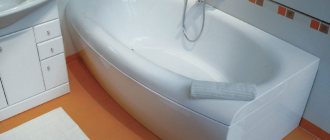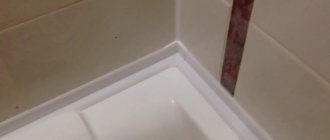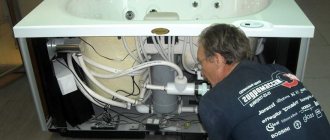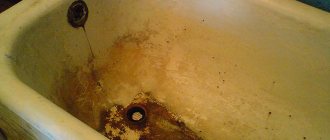Preparing to remove from the bath
If the sealant is fresh, then removing it will not be difficult , but to remove the hardened isolate you will have to make an effort, since it adheres tightly to the surface. New sealant cannot be applied to old material.
You can clean it in 2 ways: mechanical and chemical. In severe cases, these two methods must be combined.
The choice of cleaning method is influenced by what type of sealant was used to seal the bathroom. Silicone sealants come in 2 types:
Acidic. They have a characteristic odor reminiscent of vinegar essence.
It contains aggressive components, so when working with it you need to thoroughly ventilate the room. This is especially true in the case when its removal will be carried out using a chemical method. Preference should be given to formulations containing acid.- Neutral. They have almost no smell and do not contain any caustic substances. Such sealants can be safely removed both chemically and mechanically. They can be removed with acetone and other organic solvents.
Acrylic sealants are easier to clean off than silicone sealants. This material can be pryed off with a utility knife or blade. It also reacts well to solvents such as gasoline, acetone and vinegar.
Another type of sealant is siliconized . They are a combination of acrylic and silicone mixture. Such compositions are moisture resistant and harmless to humans. You can remove them in any way.
When starting to remove the material, it is recommended to seal the bathtub with masking tape. This will protect it from scratches if your hand accidentally falls off. You need to prepare tools and chemical compositions in advance.
Cleaning
You can quickly and without any consequences remove only the sealant that has not yet hardened and was recently applied. Therefore, if silicone gets on the floor, bathtub, sink, tiles or clothes, you can simply wipe it off with a regular rag or sponge. It is much more difficult to remove the sealant from the bathtub if it has already hardened.
The difficulty of removing hardened sealant depends on the type of surface and composition. The most difficult types of materials to clean are porous types of materials, such as cast iron, marble, enamel and concrete, as well as various textured surfaces, such as tiles or mosaics. If you correctly apply a high-quality type of sealant, then this composition adheres tightly to the surface, and it is very difficult to remove the sealant.
If you need to reapply the sealing compound, then the working surface must be cleaned of old material, this must be done carefully and efficiently. It is important to completely remove the old sealant, since fresh silicone adheres to old silicone very poorly. Therefore, if you remove the old sealant poorly, then most likely there will be a poor seal.
In order to remove the sealant that has managed to dry as efficiently as possible, both mechanical and chemical cleaning methods are used. In any case, it will not be possible to do this without applying physical effort, therefore, you need to start cleaning using the mechanical method. When removing old sealant using a tool, they try to slowly remove as thick a layer of silicone as possible, because chemicals dissolve a very small layer of this material.
How to remove mechanically?
To complete the work you will need the following tools:
- stationery or construction knife;
- blade;
- small spatula;
- tweezers;
- flat screwdriver;
- wooden scrapers;
- pumice.
Not all of the listed tools may be needed during the work process, but it is impossible to say exactly which of them will be more in demand and convenient. Therefore, there should be at least 2-3 options at hand.
Procedure:
Using a sharp utility knife or blade, you need to make longitudinal and transverse cuts on the sealant where it adheres to the bathtub. They should be long.- The cut edges are picked up with tweezers and pulled towards you. It is important not to overdo it here. With the right approach, the silicone will come off in thin, long strips.
- Residues and torn parts of silicone are removed using a wooden scraper or spatula.
- If some of the material gets into narrow joints, it is removed from there with tweezers or tongs.
There are no difficulties if the silicone layer is dense. It is more difficult to deal with a thin layer of sealant. For high-quality and safe cleaning, use fine-grained sandpaper, the hard side of a dishwashing sponge, or pumice.
Cleaning methods
Only fresh, not yet hardened silicone is removed quickly and without consequences. Therefore, if during the application process the product gets outside the work area (on tiles, bathtubs, sinks, floors or clothes), it should be quickly wiped off with a sponge or rag.
Fungus on silicone is the most common reason why it needs to be removed.
The difficulty of removing silicone depends on the composition and type of surface. The most difficult material to clean is porous material (concrete, marble, enamel, cast iron) or textured tiles (especially mosaics): when applied correctly, a high-quality sealant adheres tightly to such coatings.
If you plan to reapply the sealant, the working surface must be cleaned of the old layer especially carefully. There is practically no adhesion between the molecules of fresh and polymerized silicone. Therefore, if the old layer is removed poorly, poor sealing is likely.
To clean the surface of dried sealant, use a combination of mechanical and chemical means. In any case, it is impossible to do without physical effort, so the work begins with the mechanical method. At the same time, they try to gradually remove as thick a layer of silicone as possible, since chemistry can only dissolve a relatively small layer.
Mechanical method
To work you will need the following tools:
- a sharp stationery or construction knife (you can purchase a special knife for cutting silicone seams);
- blade;
- small spatula;
- tweezers;
- flat screwdriver;
- special plastic or wooden scrapers for removing sealant;
- pumice.
Some of the tools listed may not be useful, but it is better to have them at hand: in practice, you often have to try different options to find the most effective one.
Stages of work:
- Previously, thin layers of silicone are cut off with a knife or blade. To do this, longitudinal and transverse cuts are made between the surfaces and the adjacent layer of sealant. If the silicone has not hardened too much, you can try to remove it in one motion. To do this, the longitudinal cuts are made solid and as long as possible.
- The cut edges are grabbed with tweezers or fingers and strips and pieces of old silicone are separated.
- Use a spatula or special scrapers (wooden are preferred for acrylic surfaces) to remove the residue.
Cleaning off silicone residues with a glass scraper. - If silicone gets into cracks or cracks somewhere, pry it up and pull it out with tweezers, small pliers or tongs.
- The thin layer of remaining sealant is very difficult to remove, but you can try using fine sandpaper, the hard side of a dish sponge, or a pumice stone.
- To remove sealant from tiles, you can rub it with a paper eraser or pumice stone. An eraser is especially helpful when you need to clean embossed tiles without damaging them.
- Removing bathtubs and shower trays requires at least one assistant. Dismantling begins with trimming the outer layer of silicone around the entire perimeter. Then they pry up the bathtub or tray with a screwdriver and try to loosen it. If the product gives in, it is lifted and transferred to the prepared place. Otherwise, the seal continues to be cut with a knife or blade until the bath can be disconnected.
Chemical methods
Since it is almost impossible to completely remove old sealant in the bathroom using the previous method, mechanical cleaning is often supplemented with chemical treatment.
When choosing chemical products, it is important to consider the composition of the sealant. Household silicone sealants are either acidic or neutral. Acidic ones are the most common and have a specific vinegar smell when applied. When working with neutral silicone, there is almost no odor. To effectively remove acidic silicone, the active substance of the solvent must be acid; for neutral silicone, it must be gasoline or acetone.
Available means
First of all, you can use paint thinners that you have on hand. The effect of using these liquids may be different for each individual case, so they should be tried on specific silicone and on different surfaces. At home, the following products may be useful for removing sealant:
Galosh gasoline, white spirit
White spirit (or nefras) is a universal solvent that can be used to try to soften the old seal. Moisten a rag generously with the liquid and go over the desired areas. Leave for 5 – 10 minutes for absorption. If the product has worked, the sealant softens and resembles a gelatinous mass that can be easily removed with a spatula or scraper. You can try other solvents in a similar way.
White spirit works best on cast iron or enamel bathtubs, but may not be effective on acrylic surfaces.
Vinegar + alcohol
Acetic acid and alcohol are very weak solvents and are not very effective for silicone. But there are positive reviews about the use of a mixture of equal parts of vinegar essence (70%) and alcohol (50 ml each). Sometimes the composition is supplemented with 1 tbsp. l. soda ash. The product is applied from a spray bottle and allowed to act for about 30 minutes. After softening the sealant, it is also removed with a knife. In its pure form, vinegar can be used to treat a thin layer of silicone remaining after mechanical cleaning. In some cases, this helps remove residues faster.
Kerosene, gasoline and acetone can soften neutral sealants, but they have practically no effect on acidic ones.
Industrial silicone cleaners
Industrial products disrupt the structure of the sealant and cause its gradual destruction. Silicone solvents can be purchased at construction stores or auto care stores.
The principle of removing sealant with different professional compounds is the same:
- After preliminary mechanical cleaning, the product is applied with a sponge or simply with your finger (always wearing gloves).
- After a certain time (must be indicated on the packaging), the remaining product along with old silicone can be easily removed with a brush, plastic spatula or scraper. Often the necessary tools are included with the cleaner.
- Many industrial silicone solvents leave a greasy residue on the surface, often yellow in color. They are treated with a soap solution, kept for a while and washed. Laundry soap works well when lathering a sponge and treating oily areas. The foam is washed off, and the surface is wiped dry and finally degreased with acetone or white spirit, and then dried with a hairdryer.
Chemical products for removing silicone are available in the form of sprays, removers, gels or pastes. The following products received positive reviews and recommendations:
- Tytan (Selena, Poland). The active ingredient is phosphoric acid. Does not have a pungent odor. Dissolves even dried silicone. The operating time of the cleaner is 12 hours. The product is effective on textured surfaces, so it can be used to clean tiles with a three-dimensional pattern. Leaves greasy marks.
Tytan composition for removing silicone. - Universal car cleaner XADO Mottec Antisilicone (Ukraine) alcohol-based. Designed for degreasing and cleaning the surface from silicone and traces of adhesive tape. Suitable for acrylic and ceramics. Does not require rinsing and leaves no residue after drying.
XADO Mottec universal cleaner. - Silicone cleaner gel Soudal (Belgium) on a hydrocarbon basis. It is easy to apply and has a moderately pungent odor. The minimum duration of action is 10 minutes. Apply only to dry surfaces. On acrylic, stone, ceramics and plastic, preliminary testing is advisable. Leaves greasy stains.
Soudal hydrocarbon silicone remover. - Car wash aerosol Body Antisil 770 (Greece) based on organic solvents - a universal means for cleaning any surfaces. Safely removes silicone and bitumen residues, but re-treatment may be necessary.
Body Antisil degreaser. - Dow Corning (Dow Sil, USA) – a fundamentally new silicone-based solvent cleaner. Activates the process of silicone depolymerization. Safe for the environment and any surfaces, does not change the color of painted products and does not leave marks. Available in aerosols (Dow Sil OS-2 series) and liquids for dissolving old sealants (Dow Sil DS-2025 series).
Environmentally friendly aerosol solvent Dow Sil OS-2. - Solvent remover Penta-840. Removes traces of silicone from tiles, metal and acrylic surfaces. Apply with a generously moistened sponge. The surface to be treated is covered with film and left for several minutes. Remains of sealant can be easily removed with a sponge or improvised means. The product is dangerous if inhaled, in contact with skin or eyes. May cause corrosion of metals with prolonged exposure.
Penta-840
Best deals on silicone cleaners:
Note: Work with any solvents or industrial products only with gloves and in a well-ventilated area.
How to remove old and dried out ones using improvised means?
You can remove silicone sealant from the surface of the bathtub using improvised means. The most accessible and effective of them are:
- Galosh gasoline, white spirit;
- vinegar;
- alcohol.
Rules for using gasoline or white spirit:
- Apply solvent to a rag or sponge.
- Use it to walk over the surface that needs treatment.
- Leave for 10 minutes to take effect.
- Remove the softened sealant with a scraper.
White spirit and gasoline are odorous substances, so they should be used with the doors open. To avoid inhaling their vapors, it is recommended to use a respirator.
Vinegar is best used to remove acidic silicone sealants. How to use it:
Put gloves on your hands.- Moisten a sponge with essence.
- Use it to treat the desired area.
- Leave for 5-10 minutes.
- Remove the softened mass with a spatula.
If necessary, repeat the procedure again. You need to be prepared for the fact that during work there will be a strong acidic smell in the bathtub.
You can deal with silicone sealant using technical alcohol or ethanol. Procedure:
- Soak a clean rag in alcohol.
- Blot the silicone sealant with it.
- Leave for 15 minutes to take effect. If the alcohol wears off, it must be reapplied.
- Remove the composition with a wooden or metal spatula.
Using the listed products, you should try not to get on the surface of the bath itself. If a small amount of alcohol or solvent ends up on the enamel layer or acrylic, it must be removed with clean water.
Tips and tricks for application
Before applying new silicone sealant, the surface must be thoroughly cleaned of dirt and dust. Using alcohol or white spirit solution, degrease this surface. A prepared “workplace” will allow you to apply a new layer of sealant more efficiently and effectively.
It is necessary to decide how the building material will be applied - preliminary pasting of the destination with colored electrical tape or tape, possibly masking tape, or immediately. In the first case, it will be possible to ensure an even layer of applied silicone.
You can evenly distribute the sealant over the surface with your finger, but to obtain a high-quality seam, it is best to use a special spatula made of plastic. They vary in shape, edge angles and thickness, which allows you to achieve the desired result.
It is also worth adding that special attachments are sold that fit directly onto the sealant tube. A very useful thing that allows you to level the sealant in one pass.
Removing old composition from the surface of a bathtub and other products is quite simple; you just need to first familiarize yourself with the features of the procedure. In order not to damage the surfaces of the products, you need to check the reaction of the substances, otherwise the aesthetic appearance of the room may be lost.
How to scrub with specialized compounds?
There are commercially available chemicals that allow you to quickly and safely remove the sealant from your bathtub. Top 3 effective compositions:
- HG cleaner is a product for removing silicone sealant. It can be applied to different types of surfaces. The composition is intended for use in rooms with high levels of humidity. The set includes a brush and spatula for comfortable and safe work. One package is enough to treat an area of 10-15 square meters. Price – 750 rubles.
- Silicone cleaner Tytan Professional . The paste is in a convenient cartridge and is squeezed out of the spout. It can be used for different types of surfaces, to clean fresh and hardened sealant. Price – 480 rubles.
- Silicone cleaner TKK APURSIL . The product can be used to remove sealant from bathtubs, showers, hoods, and tiles. It quickly and effectively dissolves not only silicone, but also polyurethane foam. Available in spray form. Price – 255 rubles.
How to remove a fresh one?
Silicone sealant hardens within 20 minutes. If you manage to remove it during this time, then you don’t have to resort to using strong agents.
Removal instructions:
- pry off the silicone sealant with a wooden spatula and clean it off the surface;
- remove the mixture that has clogged up in the cracks with a screwdriver;
- if the sealant begins to harden, it is treated with vinegar, and the softened stains are wiped off with a paper napkin.
A hairdryer can easily remove small fresh stains. It is turned on at low power and a warm stream of air is directed at the sealant. After a minute it will soften and can be easily peeled off the surface.
How to wash clothes and wash hands
If glue gets on clothes, the cleaning sequence will be as follows:
- First, a chemical test is done on an inconspicuous area of fabric. If the composition has not damaged the structure of the fabric or changed its color, it can be applied to clothing.
- The contaminated surface is treated with a rag soaked in solvent and left for 20-30 minutes.
- After this, scrape off the sealant with a brush.
- Then the item is washed in the usual way.
Uncured silicone is removed from the skin with a plastic bag, which is applied to the hand and torn off along with the silicone glued to it.
Dried product is removed from hands using table salt. It needs to be dissolved in water (2-3 tbsp per 250 ml of water), hands are soaked in the resulting solution for 11-16 minutes. Then, using a brush, the sealant is cleaned off.
Cleaning old silicone is not an easy job and will require considerable effort. But if you do everything according to the rules, you can not only clean the bathroom of industrial glue, but also correct the seams, making them more neat and invisible.
Features of cleaning different types of bathtubs
Recommendations for removing silicone from acrylic, enamel, cast iron and steel bathtubs:
- When working with acrylic baths, do not use abrasive compounds, metal scrapers, knives, or blades. The choice should be made on wooden spatulas. Acrylic does not tolerate contact with acetone, alcohol, benzene and gasoline.
- Sealant can be removed from cast iron and steel bathtubs using chemicals and rough tools. However, it is necessary to control the force of pressure exerted on the surface.
- Enameled bathtubs should be handled with care, without any physical effort. Do not allow the instrument to fall into the bath so that it does not become chipped.
This publication will tell you about removing sealant from the surface of an acrylic bathtub.
Use of chemicals
It is often impossible to completely remove old sealant from an acrylic bathtub using a mechanical method; after mechanical treatment, various chemicals are used. When choosing chemical products, be sure to take into account what components silicone consists of. Conventional silicone compounds are made neutral and acidic.
The most common are acid mixtures; they have a specific vinegary odor during use. If you work with a neutral composition, the smell will be practically absent. To effectively remove old acid sealant, the main active ingredient in the chemical solution must be some kind of acid, and if you need to remove old neutral silicone, you need to purchase a substance with acetone or gasoline.
The nuances of cleaning tiles
The sealant can be removed from the tiles using the same compounds as for the bathtub . Preference should be given to chemicals that do not contain aggressive components. Gasoline, alcohol and vinegar cope well with this task.
A thin layer of sealant can be removed with a paper eraser or pumice stone. A school rubber band is especially helpful when the tiles have a corrugated surface.
It is not recommended to use metal tools. They can cause chips and scratches on the tile surface.
You can learn more about how to remove silicone sealant from tiles in this article.
Types of silicone sealants
Almost all sealants used in everyday life are one-component compounds. But they are divided into two groups:
Considering that acidic compositions polymerize in the presence of water, and they are much cheaper in price than neutral ones, then with a high degree of probability we can assume that it is the acetate composition that needs to be cleaned in the bathroom.
But quite often, in order to reduce the cost of products, manufacturers dilute silicone sealant with hydrocarbon raw materials, such as PVC or acrylic. In addition to deteriorating consumer properties, such additives can make it difficult to remove old silicone by chemical means. To determine the presence of fillers at home, simply set fire to a small piece of sealant.
Pure silicone burns very poorly, producing white ash consisting of silicon oxide.
If the test sample burns with a smoky flame and the release of black soot, this indicates the presence of hydrocarbons in the composition. And to purify such material, you will need to slightly change the technology.
Sealant for the bathroom - you can read about the rules for choosing it in our publication.
And from this article you can learn everything about how to waterproof a bathroom.
Helpful information
Tips for removing caulk from a bathtub:
Before you begin removing sealant using chemicals, you need to test them on an inconspicuous area. If the coating does not change its properties, you can start cleaning.- When working with chemicals, you should not forget about your own safety measures. Hands must be protected with gloves. If aerosol cans are used, wear construction goggles over the eyes and a respirator over the respiratory system.
- Immediately after removing the sealant, the treated surface should be rinsed with clean water. If the remover remains on an enamel or acrylic bath for a long time, it will lead to corrosion.
Replacing sealant
In any case, you need to choose only original products from a proven and reliable manufacturer. In addition, silicone must contain antimicrobial components - biocides. It is recommended to buy silicone compounds only in specialized stores where storage conditions are observed and where the likelihood of purchasing a counterfeit product is minimal.
After the old silicone sealant has been removed, a new compound is applied as follows:
- the surface is degreased and then thoroughly dried;
- all areas around the work area are covered with masking tape;
- the mixture is applied carefully, slowly;
- Excess solution is immediately removed. To get an even and uniform seam without defects, it is advisable to use not a finger, but an old plastic card, a ruler or a spatula;
- Before using the sealed product, you must wait 12-24 hours.
Do not apply sealing solution to wet objects. Even if the silicone sticks to the base, mold will begin to grow underneath due to the humidity. Practice shows that even the highest quality products containing antifungal substances are susceptible to mold development. Fungi and mold form on the silicone surface if the sealing solution was not applied according to technology, a counterfeit product was purchased, or there is high air humidity in the room with poor ventilation, as a result of which fungi and mold develop, and the silicone will have to be replaced.











